Accounting Information System Report - Risk and Control Analysis
VerifiedAdded on 2021/05/30
|12
|2616
|146
Report
AI Summary
This report delves into the realm of Accounting Information Systems (AIS), presenting a comprehensive analysis of risk management and internal controls through the examination of two distinct case studies. The first case, Mallacoota Marina Limited, explores operational risks such as non-collectability of debts, potential understatement of revenue, overpayment of overtime, and inventory theft, along with corresponding control measures to mitigate these risks. The second case, BAS Limited, investigates the vulnerabilities within a Financial Management System (FMS) stemming from a lack of documentation, inadequate segregation of duties, insufficient training, and authorization deficiencies. The report identifies specific issues within each case and proposes remedies to strengthen internal controls and ensure the integrity of financial data. The analysis covers various aspects of accounting, including debt management, inventory control, and financial reporting, offering practical insights into the challenges and best practices of AIS.
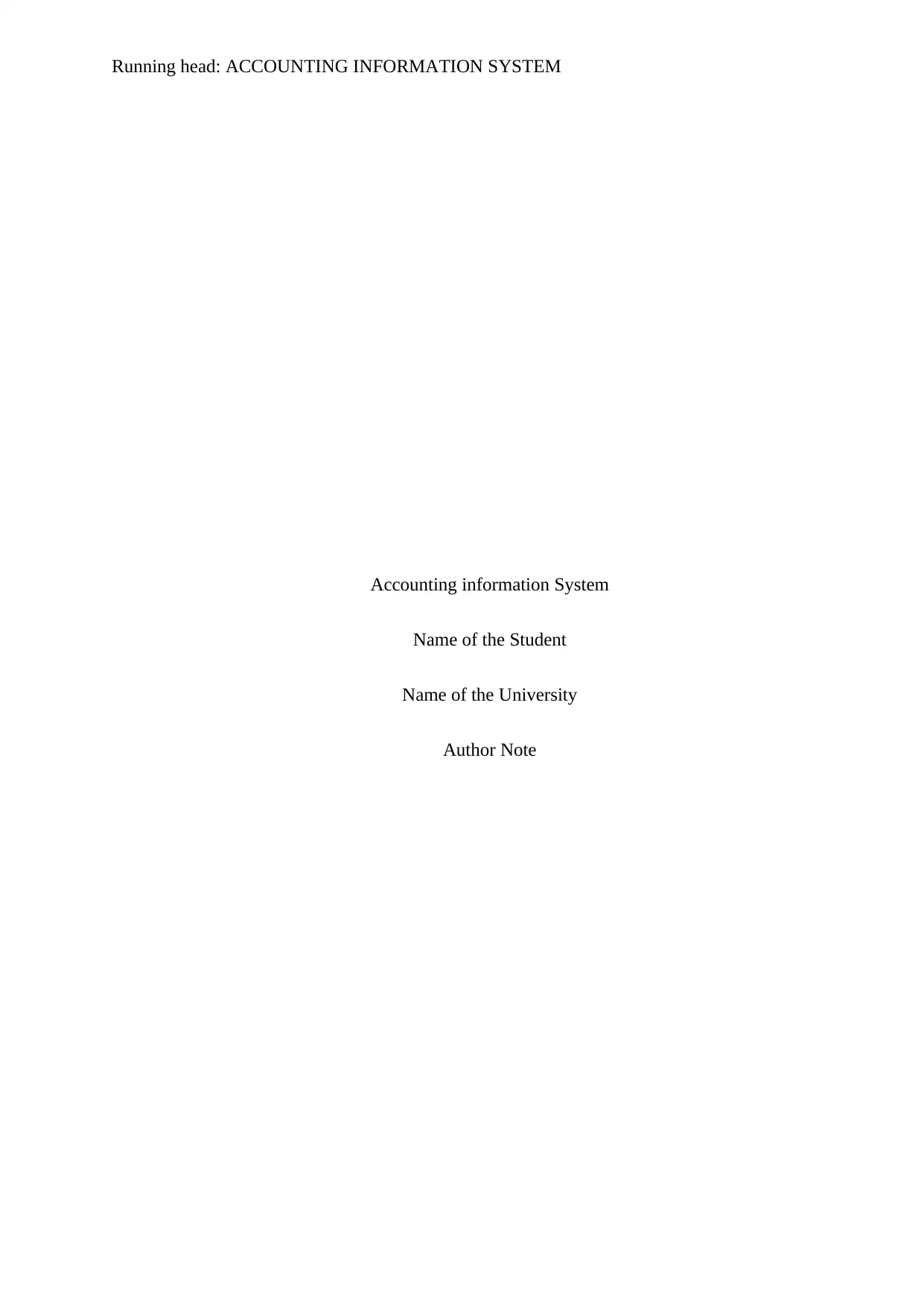
Running head: ACCOUNTING INFORMATION SYSTEM
Accounting information System
Name of the Student
Name of the University
Author Note
Accounting information System
Name of the Student
Name of the University
Author Note
Paraphrase This Document
Need a fresh take? Get an instant paraphrase of this document with our AI Paraphraser
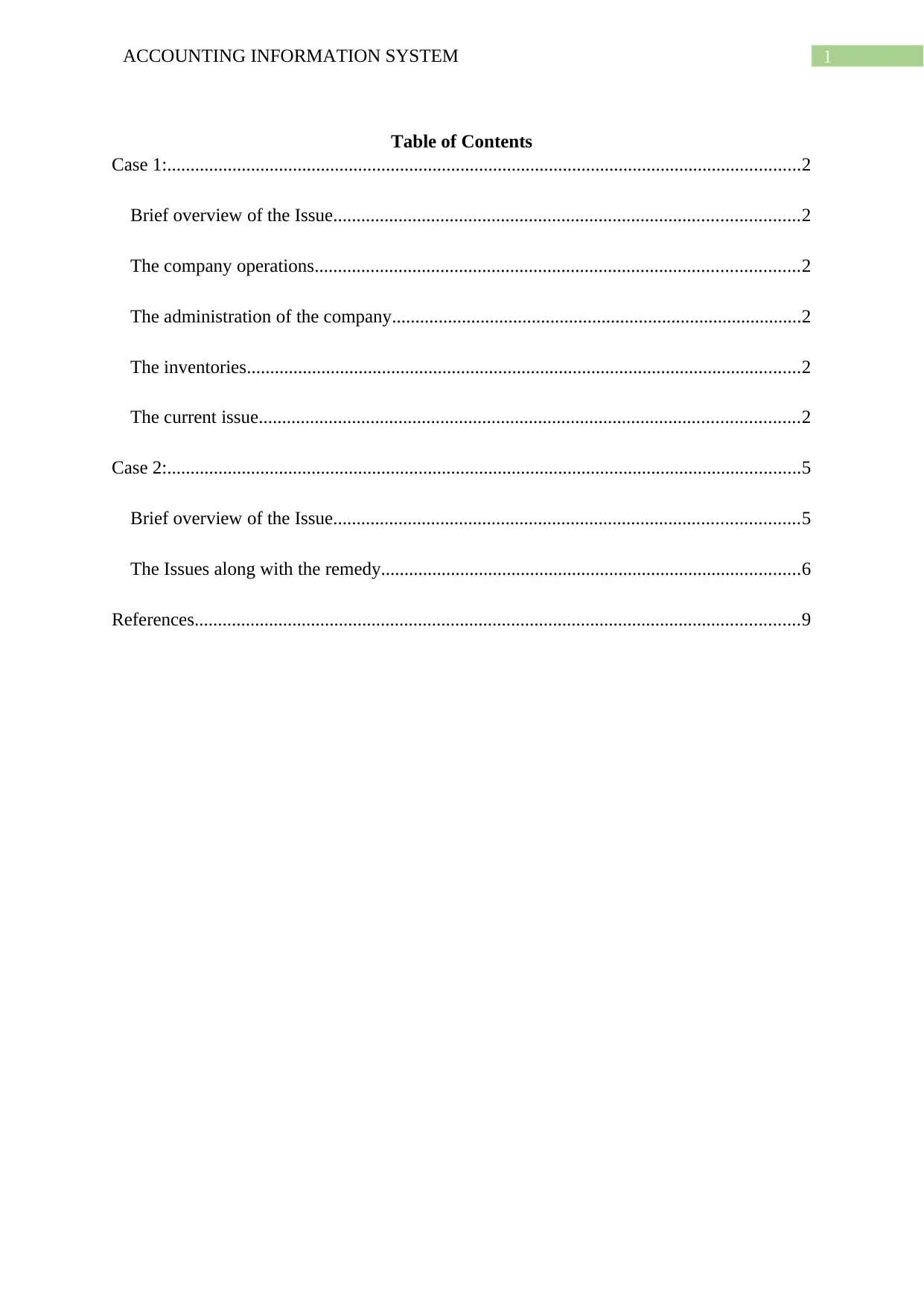
1ACCOUNTING INFORMATION SYSTEM
Table of Contents
Case 1:........................................................................................................................................2
Brief overview of the Issue....................................................................................................2
The company operations........................................................................................................2
The administration of the company........................................................................................2
The inventories.......................................................................................................................2
The current issue....................................................................................................................2
Case 2:........................................................................................................................................5
Brief overview of the Issue....................................................................................................5
The Issues along with the remedy..........................................................................................6
References..................................................................................................................................9
Table of Contents
Case 1:........................................................................................................................................2
Brief overview of the Issue....................................................................................................2
The company operations........................................................................................................2
The administration of the company........................................................................................2
The inventories.......................................................................................................................2
The current issue....................................................................................................................2
Case 2:........................................................................................................................................5
Brief overview of the Issue....................................................................................................5
The Issues along with the remedy..........................................................................................6
References..................................................................................................................................9
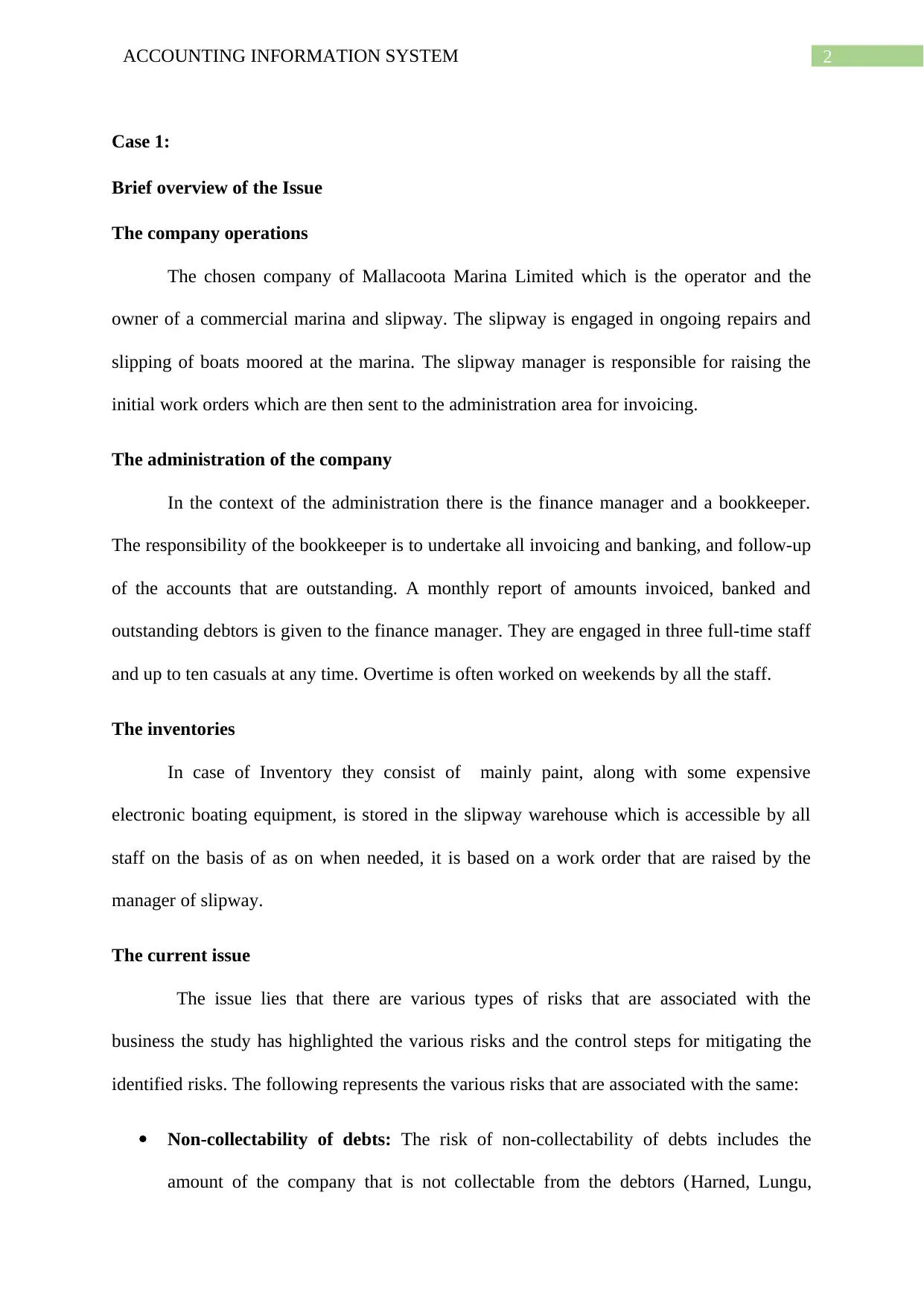
2ACCOUNTING INFORMATION SYSTEM
Case 1:
Brief overview of the Issue
The company operations
The chosen company of Mallacoota Marina Limited which is the operator and the
owner of a commercial marina and slipway. The slipway is engaged in ongoing repairs and
slipping of boats moored at the marina. The slipway manager is responsible for raising the
initial work orders which are then sent to the administration area for invoicing.
The administration of the company
In the context of the administration there is the finance manager and a bookkeeper.
The responsibility of the bookkeeper is to undertake all invoicing and banking, and follow-up
of the accounts that are outstanding. A monthly report of amounts invoiced, banked and
outstanding debtors is given to the finance manager. They are engaged in three full-time staff
and up to ten casuals at any time. Overtime is often worked on weekends by all the staff.
The inventories
In case of Inventory they consist of mainly paint, along with some expensive
electronic boating equipment, is stored in the slipway warehouse which is accessible by all
staff on the basis of as on when needed, it is based on a work order that are raised by the
manager of slipway.
The current issue
The issue lies that there are various types of risks that are associated with the
business the study has highlighted the various risks and the control steps for mitigating the
identified risks. The following represents the various risks that are associated with the same:
Non-collectability of debts: The risk of non-collectability of debts includes the
amount of the company that is not collectable from the debtors (Harned, Lungu,
Case 1:
Brief overview of the Issue
The company operations
The chosen company of Mallacoota Marina Limited which is the operator and the
owner of a commercial marina and slipway. The slipway is engaged in ongoing repairs and
slipping of boats moored at the marina. The slipway manager is responsible for raising the
initial work orders which are then sent to the administration area for invoicing.
The administration of the company
In the context of the administration there is the finance manager and a bookkeeper.
The responsibility of the bookkeeper is to undertake all invoicing and banking, and follow-up
of the accounts that are outstanding. A monthly report of amounts invoiced, banked and
outstanding debtors is given to the finance manager. They are engaged in three full-time staff
and up to ten casuals at any time. Overtime is often worked on weekends by all the staff.
The inventories
In case of Inventory they consist of mainly paint, along with some expensive
electronic boating equipment, is stored in the slipway warehouse which is accessible by all
staff on the basis of as on when needed, it is based on a work order that are raised by the
manager of slipway.
The current issue
The issue lies that there are various types of risks that are associated with the
business the study has highlighted the various risks and the control steps for mitigating the
identified risks. The following represents the various risks that are associated with the same:
Non-collectability of debts: The risk of non-collectability of debts includes the
amount of the company that is not collectable from the debtors (Harned, Lungu,
⊘ This is a preview!⊘
Do you want full access?
Subscribe today to unlock all pages.

Trusted by 1+ million students worldwide

3ACCOUNTING INFORMATION SYSTEM
Wilks and Linehan 2017). This happens when Mallacoota Marina Limited sells their
goods on credit. Although the credit sales helps in enhancing the sales but exists a risk
of bad debts. Basically the risks is the loss of amount due to monetary amount that
cannot be recovered from the buyers on credit. In order to lower down the risk the
primary step is to reduce the number of credit sales offered to the buyers. The
company must ensure that the bills are cleared on time. The company must ensure that
the payments that are overdue must be cleared on time (Ismail and King 2014).
Moreover the company must analyze the reason for which the customer is unable to
pay the amount. This involves in checking whether the customer is having a problem
with the product or whether the customer has any cash flow problem. The company
must also evaluate the type of accounting or payment system associated with the
transaction in order to mitigate the risk (Renz and Herman 2016).
Potential understatement of revenue: This is the risk that takes place in the internal
control of the business where the amount of the revenues are misstated and shown at a
lesser value. This causes the expenses to be understated. This both results in the
inaccurate measurement of a business financial position and can cause the owner to
make improper business investments and change his tax liabilities. Although
understatement commonly takes place on balance sheets, the effects of erroneous
accounting will affect the income, cash-flow and owner's equity statements of Marina
Limited (Sudaryanti, Sukoharsono, Baridwan and Mulawarman 2015). This takes
place when the business internal may fraudulently make understatements of liabilities
on their balance sheets to show more profits to investors. They may understate their
assets to lower their federal and state taxable income. Business owners who use this
method will usually keep two sets of books, one for official purposes and the other to
keep track of their actual finances. As a mitigation the company must ensure a good
Wilks and Linehan 2017). This happens when Mallacoota Marina Limited sells their
goods on credit. Although the credit sales helps in enhancing the sales but exists a risk
of bad debts. Basically the risks is the loss of amount due to monetary amount that
cannot be recovered from the buyers on credit. In order to lower down the risk the
primary step is to reduce the number of credit sales offered to the buyers. The
company must ensure that the bills are cleared on time. The company must ensure that
the payments that are overdue must be cleared on time (Ismail and King 2014).
Moreover the company must analyze the reason for which the customer is unable to
pay the amount. This involves in checking whether the customer is having a problem
with the product or whether the customer has any cash flow problem. The company
must also evaluate the type of accounting or payment system associated with the
transaction in order to mitigate the risk (Renz and Herman 2016).
Potential understatement of revenue: This is the risk that takes place in the internal
control of the business where the amount of the revenues are misstated and shown at a
lesser value. This causes the expenses to be understated. This both results in the
inaccurate measurement of a business financial position and can cause the owner to
make improper business investments and change his tax liabilities. Although
understatement commonly takes place on balance sheets, the effects of erroneous
accounting will affect the income, cash-flow and owner's equity statements of Marina
Limited (Sudaryanti, Sukoharsono, Baridwan and Mulawarman 2015). This takes
place when the business internal may fraudulently make understatements of liabilities
on their balance sheets to show more profits to investors. They may understate their
assets to lower their federal and state taxable income. Business owners who use this
method will usually keep two sets of books, one for official purposes and the other to
keep track of their actual finances. As a mitigation the company must ensure a good
Paraphrase This Document
Need a fresh take? Get an instant paraphrase of this document with our AI Paraphraser
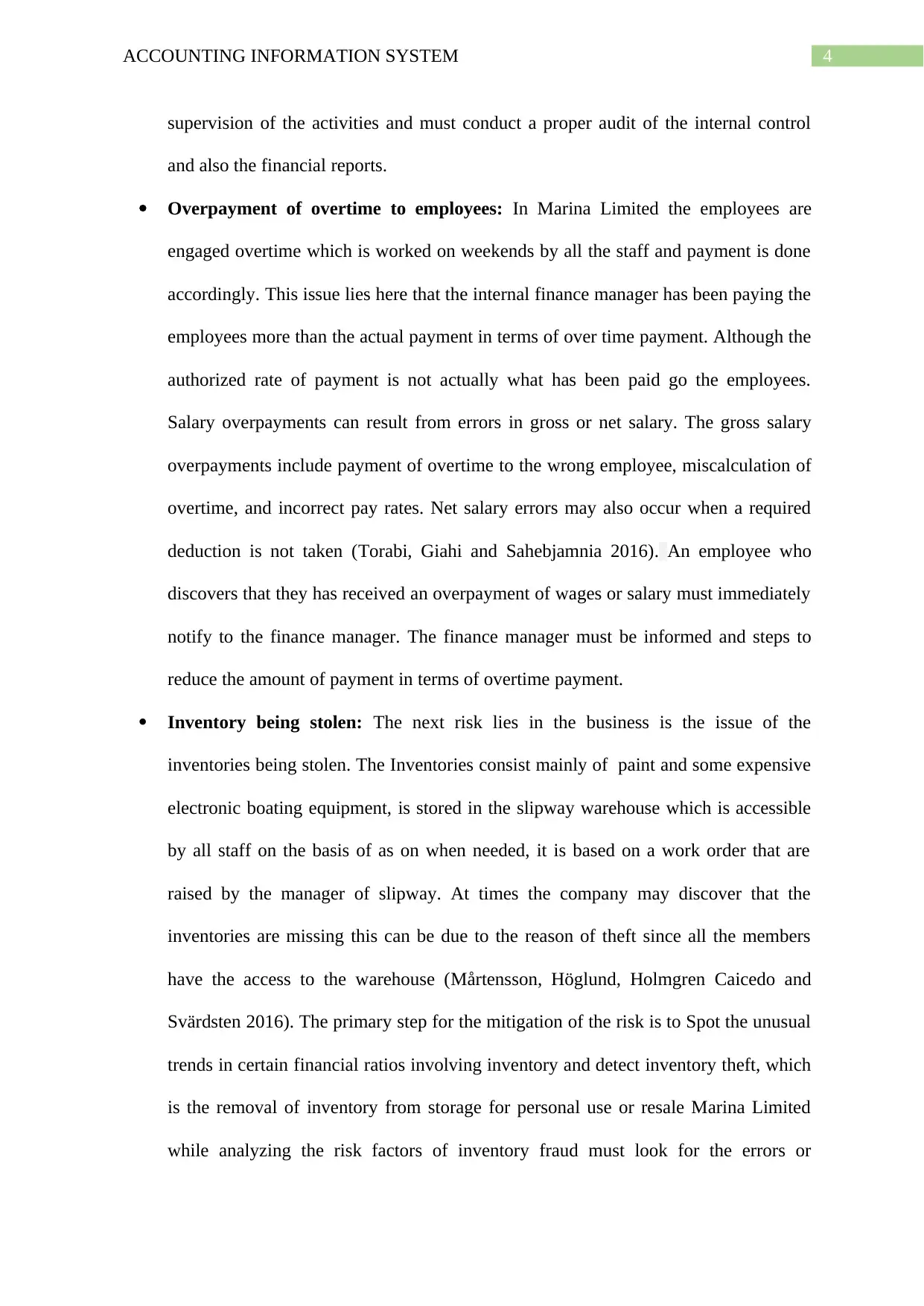
4ACCOUNTING INFORMATION SYSTEM
supervision of the activities and must conduct a proper audit of the internal control
and also the financial reports.
Overpayment of overtime to employees: In Marina Limited the employees are
engaged overtime which is worked on weekends by all the staff and payment is done
accordingly. This issue lies here that the internal finance manager has been paying the
employees more than the actual payment in terms of over time payment. Although the
authorized rate of payment is not actually what has been paid go the employees.
Salary overpayments can result from errors in gross or net salary. The gross salary
overpayments include payment of overtime to the wrong employee, miscalculation of
overtime, and incorrect pay rates. Net salary errors may also occur when a required
deduction is not taken (Torabi, Giahi and Sahebjamnia 2016). An employee who
discovers that they has received an overpayment of wages or salary must immediately
notify to the finance manager. The finance manager must be informed and steps to
reduce the amount of payment in terms of overtime payment.
Inventory being stolen: The next risk lies in the business is the issue of the
inventories being stolen. The Inventories consist mainly of paint and some expensive
electronic boating equipment, is stored in the slipway warehouse which is accessible
by all staff on the basis of as on when needed, it is based on a work order that are
raised by the manager of slipway. At times the company may discover that the
inventories are missing this can be due to the reason of theft since all the members
have the access to the warehouse (Mårtensson, Höglund, Holmgren Caicedo and
Svärdsten 2016). The primary step for the mitigation of the risk is to Spot the unusual
trends in certain financial ratios involving inventory and detect inventory theft, which
is the removal of inventory from storage for personal use or resale Marina Limited
while analyzing the risk factors of inventory fraud must look for the errors or
supervision of the activities and must conduct a proper audit of the internal control
and also the financial reports.
Overpayment of overtime to employees: In Marina Limited the employees are
engaged overtime which is worked on weekends by all the staff and payment is done
accordingly. This issue lies here that the internal finance manager has been paying the
employees more than the actual payment in terms of over time payment. Although the
authorized rate of payment is not actually what has been paid go the employees.
Salary overpayments can result from errors in gross or net salary. The gross salary
overpayments include payment of overtime to the wrong employee, miscalculation of
overtime, and incorrect pay rates. Net salary errors may also occur when a required
deduction is not taken (Torabi, Giahi and Sahebjamnia 2016). An employee who
discovers that they has received an overpayment of wages or salary must immediately
notify to the finance manager. The finance manager must be informed and steps to
reduce the amount of payment in terms of overtime payment.
Inventory being stolen: The next risk lies in the business is the issue of the
inventories being stolen. The Inventories consist mainly of paint and some expensive
electronic boating equipment, is stored in the slipway warehouse which is accessible
by all staff on the basis of as on when needed, it is based on a work order that are
raised by the manager of slipway. At times the company may discover that the
inventories are missing this can be due to the reason of theft since all the members
have the access to the warehouse (Mårtensson, Höglund, Holmgren Caicedo and
Svärdsten 2016). The primary step for the mitigation of the risk is to Spot the unusual
trends in certain financial ratios involving inventory and detect inventory theft, which
is the removal of inventory from storage for personal use or resale Marina Limited
while analyzing the risk factors of inventory fraud must look for the errors or

5ACCOUNTING INFORMATION SYSTEM
misstatements in reported inventory balances. The process of overstating and
understating the ending inventory balances can inflate and reduce profits,
respectively. Overstated profits make management look good, while understated
profits reduce taxable income.
Payments being made twice to the same supplier: This risk may mistakenly occur
when the payments are made twice to the supplier. It can be said to be a major
financial drain faced by the organizations at present, where accidently the
management may pay the same invoice twice. As a solution to the issue the accounts
payable system should be redesigned to accommodate only one vendor master file
record for each supplier. However, there are some activities that can prompt the
duplication of a vendor master file. In addition to this there must be double check
for misleading and misreading of the payments. The company must ensure that
there’s a solid backup and that payment information is entered into the system
immediately upon issuing the check (Eldenburg, Wolcott, Chen and Cook 2016). The
best way to prevent the risk is to get the vendors send the invoices one way. If the
accounts payable department has one way of receiving invoices, it will be able to
more easily track and identify duplicate invoices.
Case 2:
Brief overview of the Issue
The key modules of Financial Management System (FMS) of BAS Limited are at
present undergoing the significant modification. The systems analyst who initially
implemented the FMS was dismissed recently due to a disagreement with the IT Manager.
misstatements in reported inventory balances. The process of overstating and
understating the ending inventory balances can inflate and reduce profits,
respectively. Overstated profits make management look good, while understated
profits reduce taxable income.
Payments being made twice to the same supplier: This risk may mistakenly occur
when the payments are made twice to the supplier. It can be said to be a major
financial drain faced by the organizations at present, where accidently the
management may pay the same invoice twice. As a solution to the issue the accounts
payable system should be redesigned to accommodate only one vendor master file
record for each supplier. However, there are some activities that can prompt the
duplication of a vendor master file. In addition to this there must be double check
for misleading and misreading of the payments. The company must ensure that
there’s a solid backup and that payment information is entered into the system
immediately upon issuing the check (Eldenburg, Wolcott, Chen and Cook 2016). The
best way to prevent the risk is to get the vendors send the invoices one way. If the
accounts payable department has one way of receiving invoices, it will be able to
more easily track and identify duplicate invoices.
Case 2:
Brief overview of the Issue
The key modules of Financial Management System (FMS) of BAS Limited are at
present undergoing the significant modification. The systems analyst who initially
implemented the FMS was dismissed recently due to a disagreement with the IT Manager.
⊘ This is a preview!⊘
Do you want full access?
Subscribe today to unlock all pages.

Trusted by 1+ million students worldwide
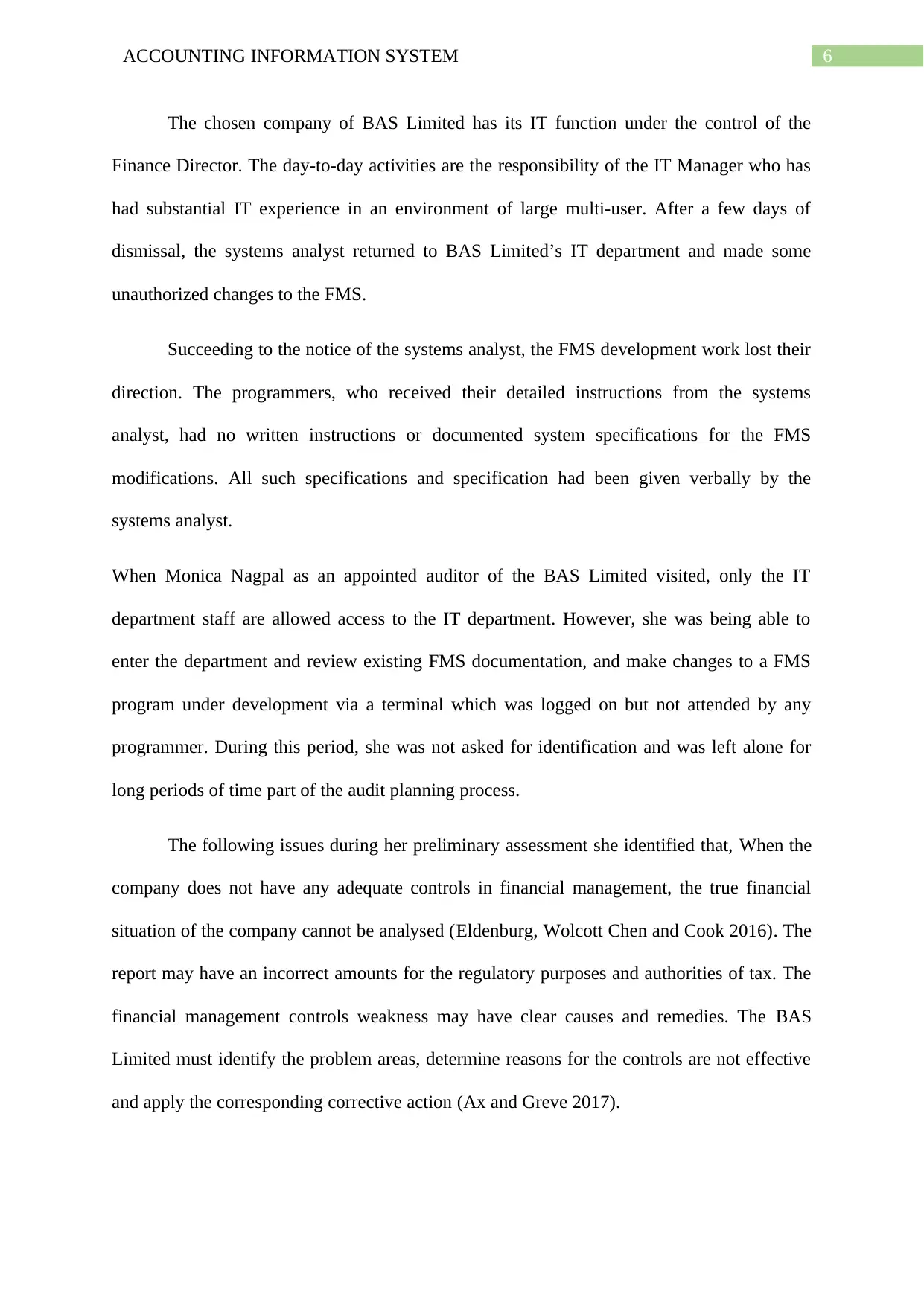
6ACCOUNTING INFORMATION SYSTEM
The chosen company of BAS Limited has its IT function under the control of the
Finance Director. The day-to-day activities are the responsibility of the IT Manager who has
had substantial IT experience in an environment of large multi-user. After a few days of
dismissal, the systems analyst returned to BAS Limited’s IT department and made some
unauthorized changes to the FMS.
Succeeding to the notice of the systems analyst, the FMS development work lost their
direction. The programmers, who received their detailed instructions from the systems
analyst, had no written instructions or documented system specifications for the FMS
modifications. All such specifications and specification had been given verbally by the
systems analyst.
When Monica Nagpal as an appointed auditor of the BAS Limited visited, only the IT
department staff are allowed access to the IT department. However, she was being able to
enter the department and review existing FMS documentation, and make changes to a FMS
program under development via a terminal which was logged on but not attended by any
programmer. During this period, she was not asked for identification and was left alone for
long periods of time part of the audit planning process.
The following issues during her preliminary assessment she identified that, When the
company does not have any adequate controls in financial management, the true financial
situation of the company cannot be analysed (Eldenburg, Wolcott Chen and Cook 2016). The
report may have an incorrect amounts for the regulatory purposes and authorities of tax. The
financial management controls weakness may have clear causes and remedies. The BAS
Limited must identify the problem areas, determine reasons for the controls are not effective
and apply the corresponding corrective action (Ax and Greve 2017).
The chosen company of BAS Limited has its IT function under the control of the
Finance Director. The day-to-day activities are the responsibility of the IT Manager who has
had substantial IT experience in an environment of large multi-user. After a few days of
dismissal, the systems analyst returned to BAS Limited’s IT department and made some
unauthorized changes to the FMS.
Succeeding to the notice of the systems analyst, the FMS development work lost their
direction. The programmers, who received their detailed instructions from the systems
analyst, had no written instructions or documented system specifications for the FMS
modifications. All such specifications and specification had been given verbally by the
systems analyst.
When Monica Nagpal as an appointed auditor of the BAS Limited visited, only the IT
department staff are allowed access to the IT department. However, she was being able to
enter the department and review existing FMS documentation, and make changes to a FMS
program under development via a terminal which was logged on but not attended by any
programmer. During this period, she was not asked for identification and was left alone for
long periods of time part of the audit planning process.
The following issues during her preliminary assessment she identified that, When the
company does not have any adequate controls in financial management, the true financial
situation of the company cannot be analysed (Eldenburg, Wolcott Chen and Cook 2016). The
report may have an incorrect amounts for the regulatory purposes and authorities of tax. The
financial management controls weakness may have clear causes and remedies. The BAS
Limited must identify the problem areas, determine reasons for the controls are not effective
and apply the corresponding corrective action (Ax and Greve 2017).
Paraphrase This Document
Need a fresh take? Get an instant paraphrase of this document with our AI Paraphraser
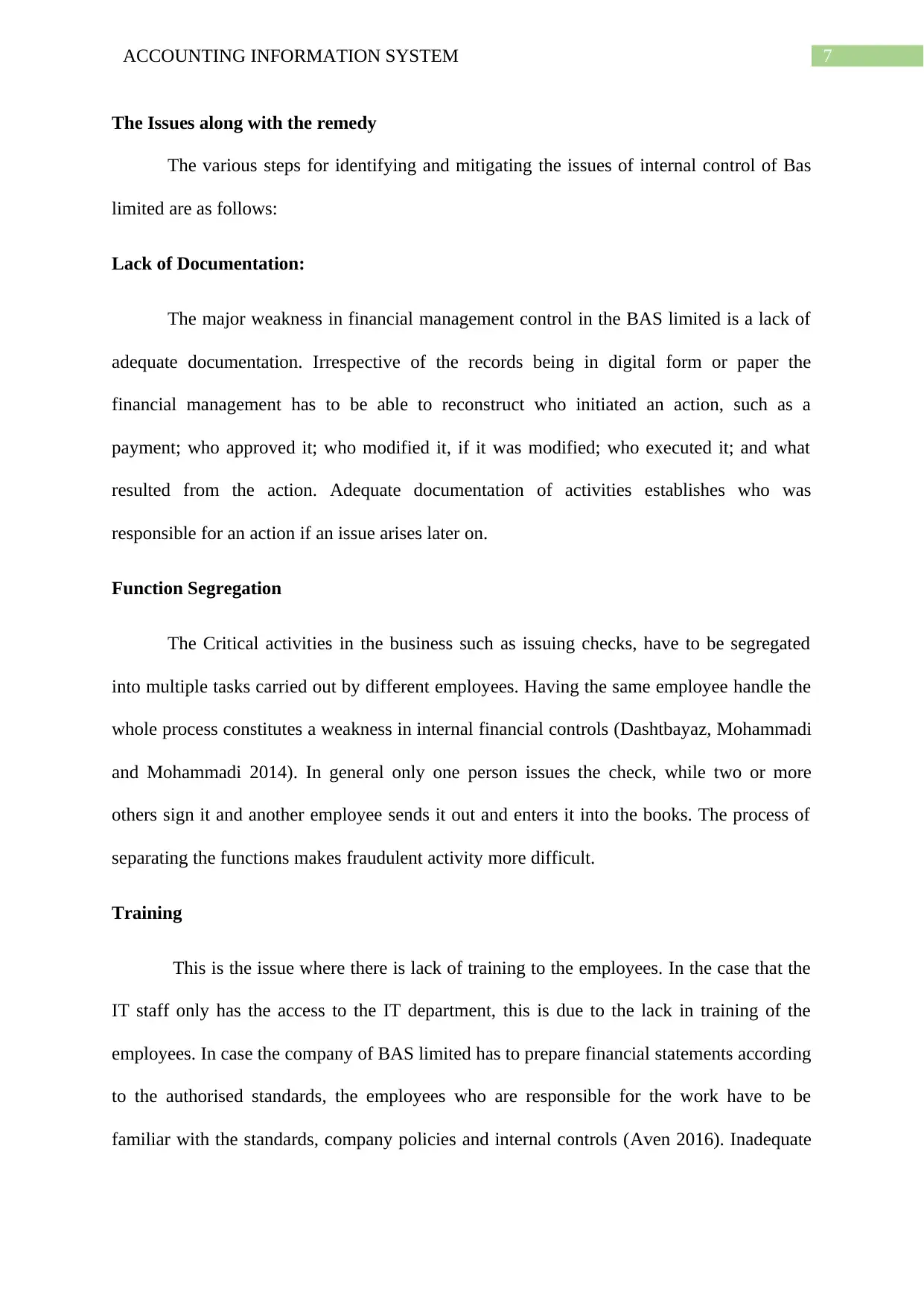
7ACCOUNTING INFORMATION SYSTEM
The Issues along with the remedy
The various steps for identifying and mitigating the issues of internal control of Bas
limited are as follows:
Lack of Documentation:
The major weakness in financial management control in the BAS limited is a lack of
adequate documentation. Irrespective of the records being in digital form or paper the
financial management has to be able to reconstruct who initiated an action, such as a
payment; who approved it; who modified it, if it was modified; who executed it; and what
resulted from the action. Adequate documentation of activities establishes who was
responsible for an action if an issue arises later on.
Function Segregation
The Critical activities in the business such as issuing checks, have to be segregated
into multiple tasks carried out by different employees. Having the same employee handle the
whole process constitutes a weakness in internal financial controls (Dashtbayaz, Mohammadi
and Mohammadi 2014). In general only one person issues the check, while two or more
others sign it and another employee sends it out and enters it into the books. The process of
separating the functions makes fraudulent activity more difficult.
Training
This is the issue where there is lack of training to the employees. In the case that the
IT staff only has the access to the IT department, this is due to the lack in training of the
employees. In case the company of BAS limited has to prepare financial statements according
to the authorised standards, the employees who are responsible for the work have to be
familiar with the standards, company policies and internal controls (Aven 2016). Inadequate
The Issues along with the remedy
The various steps for identifying and mitigating the issues of internal control of Bas
limited are as follows:
Lack of Documentation:
The major weakness in financial management control in the BAS limited is a lack of
adequate documentation. Irrespective of the records being in digital form or paper the
financial management has to be able to reconstruct who initiated an action, such as a
payment; who approved it; who modified it, if it was modified; who executed it; and what
resulted from the action. Adequate documentation of activities establishes who was
responsible for an action if an issue arises later on.
Function Segregation
The Critical activities in the business such as issuing checks, have to be segregated
into multiple tasks carried out by different employees. Having the same employee handle the
whole process constitutes a weakness in internal financial controls (Dashtbayaz, Mohammadi
and Mohammadi 2014). In general only one person issues the check, while two or more
others sign it and another employee sends it out and enters it into the books. The process of
separating the functions makes fraudulent activity more difficult.
Training
This is the issue where there is lack of training to the employees. In the case that the
IT staff only has the access to the IT department, this is due to the lack in training of the
employees. In case the company of BAS limited has to prepare financial statements according
to the authorised standards, the employees who are responsible for the work have to be
familiar with the standards, company policies and internal controls (Aven 2016). Inadequate

8ACCOUNTING INFORMATION SYSTEM
training of employees in key positions of responsibility constitutes a weakness in internal
financial management.
Deficiency Reporting
Then comes the issue of deficiencies that can occur in the execution or design of the
processes and procedures, but financial management has to target both possibilities with
monitoring that detects discrepancies and issues that are corresponding reports. This may
occur when a software is not tracking important documents or an employee forgets to issue
required forms, employees in charge of verifying documentation have to issue a non-
compliance report.
Authorization
The issue of neglecting to track the approvals to make sure that employees are not
exceeding their authorization levels is a key internal control function weakness. The
Employees have an authorization to sign for spending limits and certain functions below
which they can approve the expenditures. If an employee does not respect his limits, it
represents a serious weakness in internal financial controls.
Reconciliation
The Employees of the BAS limited compile the important variables within a business
from multiple sources. At times, they may take physical inventory of products on hand but
also calculate inventory from products received and products sold (Aven 2015). In case of
lack of reconciliation between the two sources is a weakness in internal financial controls. A
sound reconciliation identifies the differences between the two sources and finds explanations
that result in improvements. A lack of reconciliation means the business does not account for
differences.
training of employees in key positions of responsibility constitutes a weakness in internal
financial management.
Deficiency Reporting
Then comes the issue of deficiencies that can occur in the execution or design of the
processes and procedures, but financial management has to target both possibilities with
monitoring that detects discrepancies and issues that are corresponding reports. This may
occur when a software is not tracking important documents or an employee forgets to issue
required forms, employees in charge of verifying documentation have to issue a non-
compliance report.
Authorization
The issue of neglecting to track the approvals to make sure that employees are not
exceeding their authorization levels is a key internal control function weakness. The
Employees have an authorization to sign for spending limits and certain functions below
which they can approve the expenditures. If an employee does not respect his limits, it
represents a serious weakness in internal financial controls.
Reconciliation
The Employees of the BAS limited compile the important variables within a business
from multiple sources. At times, they may take physical inventory of products on hand but
also calculate inventory from products received and products sold (Aven 2015). In case of
lack of reconciliation between the two sources is a weakness in internal financial controls. A
sound reconciliation identifies the differences between the two sources and finds explanations
that result in improvements. A lack of reconciliation means the business does not account for
differences.
⊘ This is a preview!⊘
Do you want full access?
Subscribe today to unlock all pages.

Trusted by 1+ million students worldwide
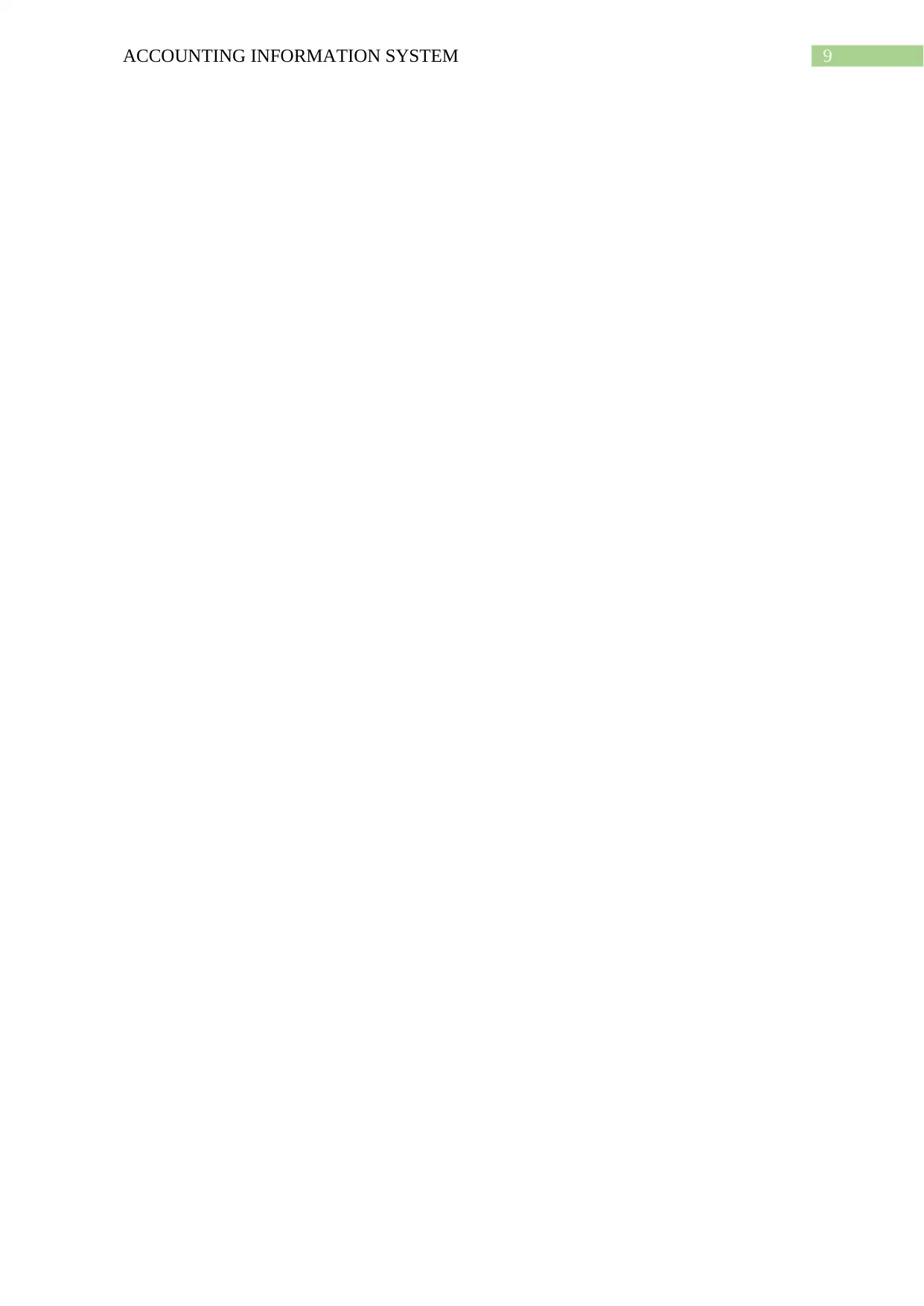
9ACCOUNTING INFORMATION SYSTEM
Paraphrase This Document
Need a fresh take? Get an instant paraphrase of this document with our AI Paraphraser

10ACCOUNTING INFORMATION SYSTEM
References
1. Ax, C. and Greve, J., 2017. Adoption of management accounting innovations:
Organizational culture compatibility and perceived outcomes. Management
Accounting Research, 34, pp.59-74.
2. Dashtbayaz, M.L., Mohammadi, S. and Mohammadi, A., 2014. Strategic
Management Accounting. Research Journal of Finance and Accounting, 5(23), pp.17-
21.
3. Eldenburg, L.G., Wolcott, S.K., Chen, L.H. and Cook, G., 2016. Cost management:
Measuring, monitoring, and motivating performance. Wiley Global Education.
4. Fullerton, R.R., Kennedy, F.A. and Widener, S.K., 2014. Lean manufacturing and
firm performance: The incremental contribution of lean management accounting
practices. Journal of Operations Management, 32(7-8), pp.414-428.
5. Hassan, H., Nasir, M.H.M. and Khairudin, N., 2017. Accounting Information
Systems. In SHS Web of Conferences(Vol. 34). EDP Sciences.
6. Ismail, N.A. and King, M., 2014. Factors influencing the alignment of accounting
information systems in small and medium sized Malaysian manufacturing
firms. Journal of Information Systems and Small Business, 1(1-2), pp.1-20.
7. Mårtensson, M., Höglund, L., Holmgren Caicedo, M. and Svärdsten, F., 2016.
Management accounting of control practices: a matter of and for strategy. In the 9TH
INTERNATIONAL EIASM PUBLIC SECTOR CONFERENCE, held in LISBON,
PORTUGAL, SEPTEMBER 6-8, 2016..
8. Nitzl, C., 2018. Management Accounting and Partial Least Squares-Structural
Equation Modelling (PLS-SEM): Some Illustrative Examples. In Partial Least
Squares Structural Equation Modeling (pp. 211-229). Springer, Cham.
References
1. Ax, C. and Greve, J., 2017. Adoption of management accounting innovations:
Organizational culture compatibility and perceived outcomes. Management
Accounting Research, 34, pp.59-74.
2. Dashtbayaz, M.L., Mohammadi, S. and Mohammadi, A., 2014. Strategic
Management Accounting. Research Journal of Finance and Accounting, 5(23), pp.17-
21.
3. Eldenburg, L.G., Wolcott, S.K., Chen, L.H. and Cook, G., 2016. Cost management:
Measuring, monitoring, and motivating performance. Wiley Global Education.
4. Fullerton, R.R., Kennedy, F.A. and Widener, S.K., 2014. Lean manufacturing and
firm performance: The incremental contribution of lean management accounting
practices. Journal of Operations Management, 32(7-8), pp.414-428.
5. Hassan, H., Nasir, M.H.M. and Khairudin, N., 2017. Accounting Information
Systems. In SHS Web of Conferences(Vol. 34). EDP Sciences.
6. Ismail, N.A. and King, M., 2014. Factors influencing the alignment of accounting
information systems in small and medium sized Malaysian manufacturing
firms. Journal of Information Systems and Small Business, 1(1-2), pp.1-20.
7. Mårtensson, M., Höglund, L., Holmgren Caicedo, M. and Svärdsten, F., 2016.
Management accounting of control practices: a matter of and for strategy. In the 9TH
INTERNATIONAL EIASM PUBLIC SECTOR CONFERENCE, held in LISBON,
PORTUGAL, SEPTEMBER 6-8, 2016..
8. Nitzl, C., 2018. Management Accounting and Partial Least Squares-Structural
Equation Modelling (PLS-SEM): Some Illustrative Examples. In Partial Least
Squares Structural Equation Modeling (pp. 211-229). Springer, Cham.
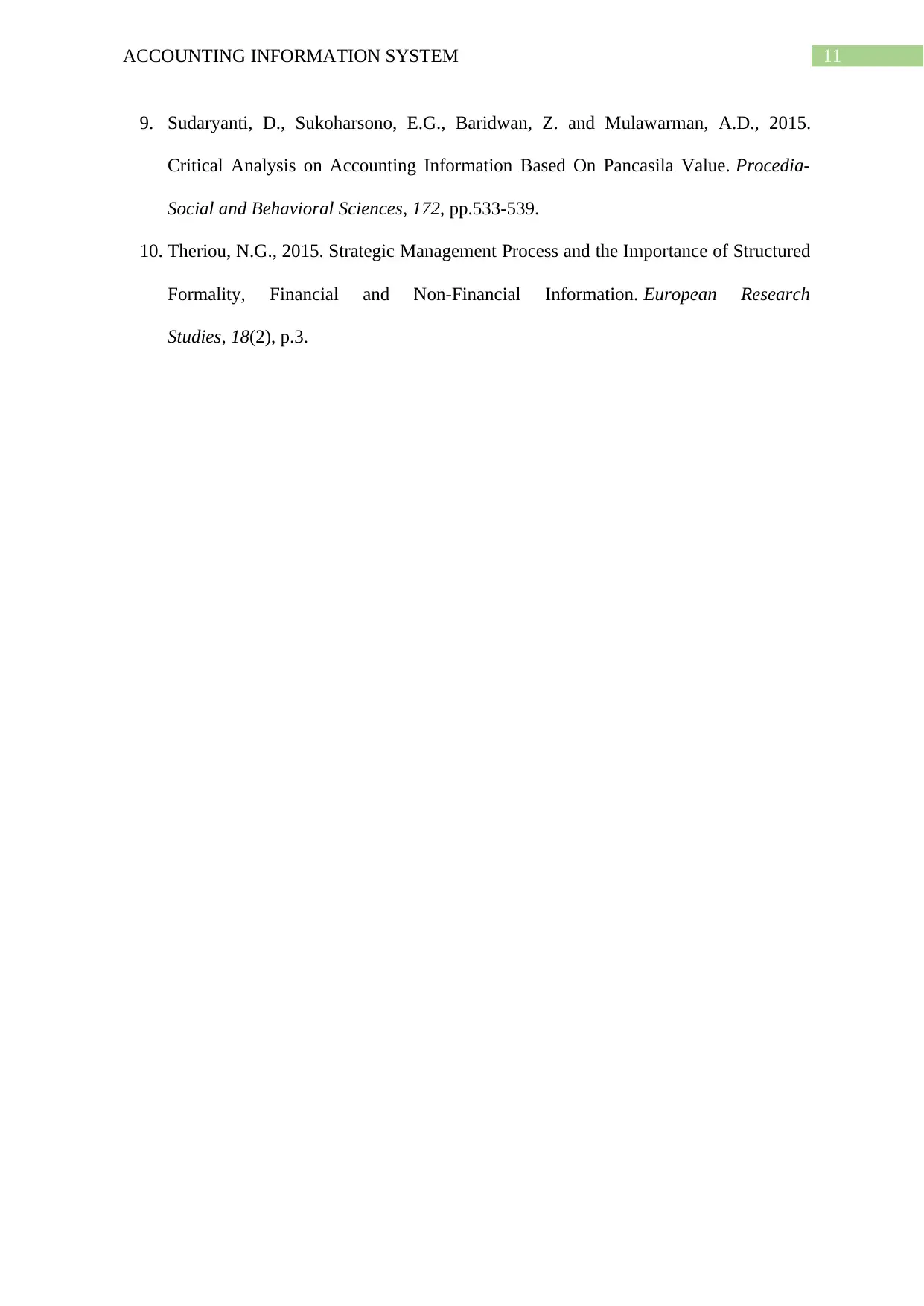
11ACCOUNTING INFORMATION SYSTEM
9. Sudaryanti, D., Sukoharsono, E.G., Baridwan, Z. and Mulawarman, A.D., 2015.
Critical Analysis on Accounting Information Based On Pancasila Value. Procedia-
Social and Behavioral Sciences, 172, pp.533-539.
10. Theriou, N.G., 2015. Strategic Management Process and the Importance of Structured
Formality, Financial and Non-Financial Information. European Research
Studies, 18(2), p.3.
9. Sudaryanti, D., Sukoharsono, E.G., Baridwan, Z. and Mulawarman, A.D., 2015.
Critical Analysis on Accounting Information Based On Pancasila Value. Procedia-
Social and Behavioral Sciences, 172, pp.533-539.
10. Theriou, N.G., 2015. Strategic Management Process and the Importance of Structured
Formality, Financial and Non-Financial Information. European Research
Studies, 18(2), p.3.
⊘ This is a preview!⊘
Do you want full access?
Subscribe today to unlock all pages.

Trusted by 1+ million students worldwide
1 out of 12
Related Documents
Your All-in-One AI-Powered Toolkit for Academic Success.
+13062052269
info@desklib.com
Available 24*7 on WhatsApp / Email
![[object Object]](/_next/static/media/star-bottom.7253800d.svg)
Unlock your academic potential
Copyright © 2020–2025 A2Z Services. All Rights Reserved. Developed and managed by ZUCOL.





